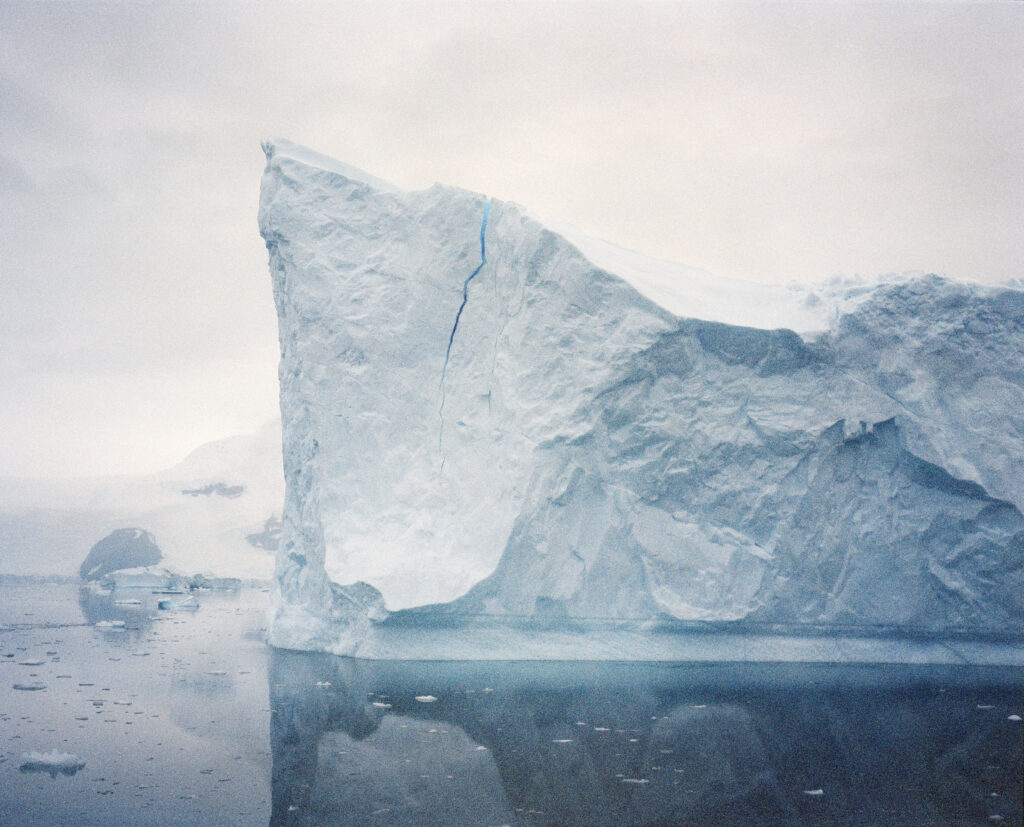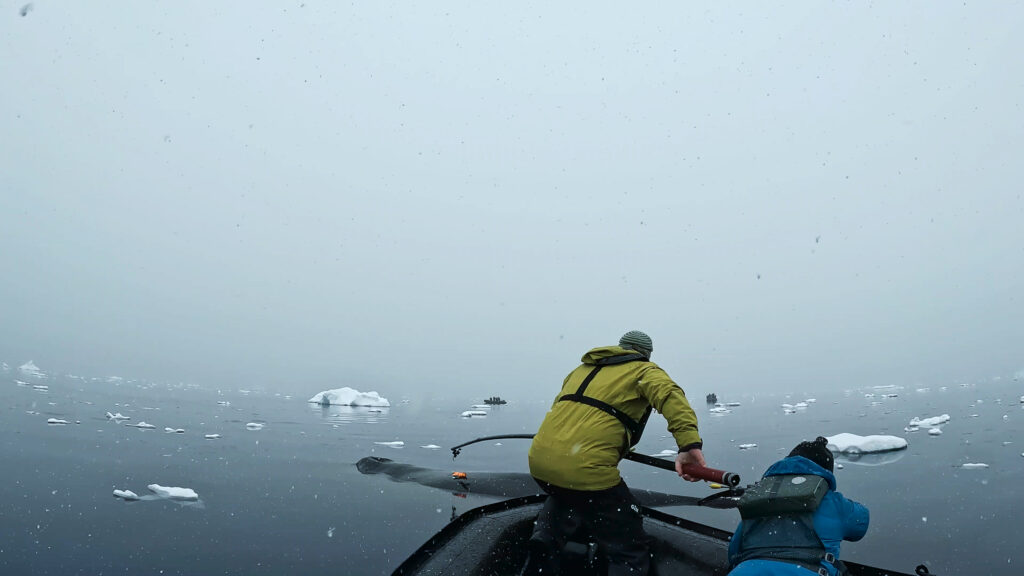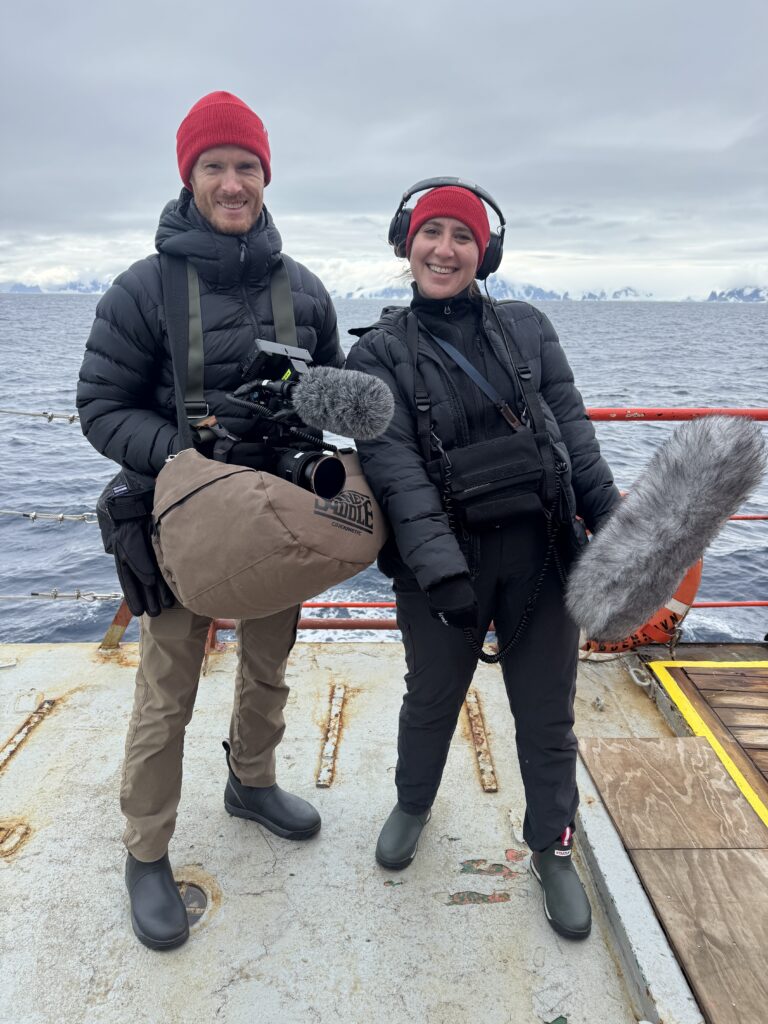In a tiny boat 7,800 miles from UC Berkeley, graduate students made a daring documentary
The journalism master's students, who graduate this month, filmed their thesis about a once-in-a-lifetime scientific expedition to Antarctica to study whales.

Courtesy of Zoe Anne Rosenblum
May 12, 2025
This January, in a 20-degree-Fahrenheit chill aboard the 130-foot-long ice tug Argus, UC Berkeley graduate students Zoe Anne Rosenblum and Matthew Busch put their faith in plastic trash bags.
They’d lugged high-definition cameras from California to Antarctica and needed the bags to protect their gear from a barrage of snow. As second-year master’s degree students studying documentary film at the School of Journalism, they were at the bottom of the world to gather crucial footage for their thesis, which chronicles various scientists — and the whales and waters they’re studying — on a once-in-a-lifetime expedition.

© Matthew Busch, All Rights Reserved
The duo’s documentary, Chasing Whales, originated at “Philomathia Day,” a day-long exploration of documentary film and environmentally focused art and science. Academy Award-nominated director Jennifer Redfearn, the 2023 Philomathia Prize winner and head of Berkeley’s documentary film program, had organized the event, and a featured speaker’s work on climate change and commercial fishing’s impact on whales piqued her interest. Eventually, she introduced Busch and Rosenblum to that researcher — UC Santa Cruz professor Ari Friedlaender — and, along with her colleague Jason Spingarn-Koff, obtained funding from the Fine Cut Fund, Philomathia Prize and the Pulitzer Center for the project.
The two journalism students “had this unique perspective, which was to edit together what the scientists were doing with a lot of the footage from the whale’s perspective. They were approaching it from both a strong storytelling [angle] but also with a lyrical eye and a real sensitivity to the animal,” Redfearn said. The directors will incorporate whale soundscapes in their film, as well as drone footage and video from miniature cameras that researchers attached to the whales.

Courtesy of the Friedlaender Lab
What Busch described as a “dream team trip of whale researchers” included scientists from a grab bag of prominent universities, including UCSC, Duke, Stanford and the University of Miami, and all conducting different projects. Friedlaender tagged humpback whales while another team evaluated their heart rates, which can help establish baselines to track their overall health. University of Miami scientist Ved Chirayath, meanwhile, used drone sensors he invented for NASA to capture data on whales and organic matter below the ocean’s surface. Because the expedition was privately funded, they were able to collect data in a more intensive way. The researchers hoped their findings could also bolster advocacy to protect whales’ “blue corridors,” or migratory pathways.
Filming any documentary requires prep work, but filming on a boat in an inhospitable ocean requires much more. Beyond planning interview questions, establishing a style of cinematography and shipping equipment to the tip of Chile, Busch and Rosenblum budgeted and practiced filming aboard zodiac boats at the Berkeley Aquatic Center. They also traveled to spend several days with some of the scientists before the journey to build rapport and accustom them to being filmed.

Peter Von Der Porten
When the day finally came to depart, the students awoke at 3 a.m. and set off on a 48-hour journey that took them first to the tip of Chile; then by plane to King George Island, known as the “Gateway to the Antarctic”; and finally aboard the fire engine-red Argus to cross the turbulent Gerlache Strait and arrive in Western Antarctica.
Once on the Argus, it was go time. They slept with a fully prepped equipment under their beds, ready to film at a moment’s notice. They followed the scientists’ successes and setbacks and marveled at the stark blue-and-white landscape and the way penguins launch themselves into and out of the water. They figured out how to film with bulky cameras in the narrow corridors of the tiny vessel.
After nearly two weeks at sea, Rosenblum and Busch returned to campus with dozens of hours of footage to sift through.

Courtesy of Zoe Anne Rosenblum
In a few weeks, the duo will screen a finished version of Chasing Whales, along with the other 25-minute documentaries completed by journalism students getting their master’s degrees this spring. Six of the 10 student films received support from Redfearn’s Philomathia Prize due to their environmental focuses. One documentary, for example, chronicles Himalayan communities turning to artificial glaciers to store irrigation water, while another tracks two sisters’ fight to get clean water in California’s first historically Black town. The master’s project seminar, which is modeled on the producing and directing process in the film industry, will wrap up a few weeks later with a distribution summit, where students can interact with potential publishers, like the New York Times Op-Docs or the New Yorker.
When viewers finally get to watch the film, Rosenblum hopes they’ll “get a sense of how important a place like Antarctica is for our planet and for the animals that use it as a sort of haven,” she said. “Even though it is a remote place, we are all connected to it.”